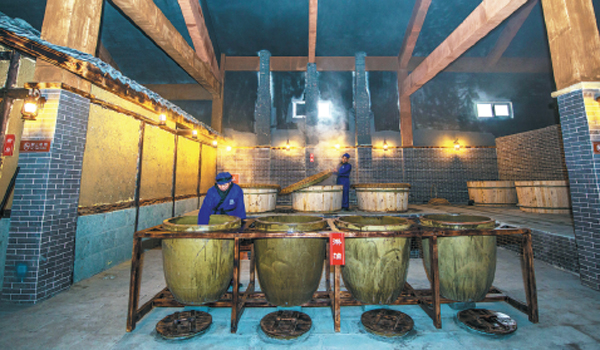Guards of honor
 |
|
A worker prepares cooking sauce for the traditional condiment maker Qingxiangyuan. [Photo provided to China Daily] |
All the handling is manual.
Pixan was named a Chinese time-honored in 1988, 300 years after it was first made. It is said to have been a creation of happenstance when a man named Chen Yijian took broad beans with him as his family migrated from Fujian province to Pixian county in Sichuan.
The beans became mildewed on the way, but Chen was reluctant to throw them away. He sundried them and mixed them with fresh pepper before fermenting them for several days. To his surprise, the beans were delicious.
After generations of refinement, it seems that few Sichuan dishes would be worthy of their name without at least a dash of Pixian sauce, and can easily elevate a dish with its spicy, lingering mellow flavor.
However, preparing the mixture before it is put into the fermenting pot is anything but easy, requiring extremely delicate handling and timing. The experts say it is vital to get the proportion of bacteria-carrying flour and water exactly right. Boiled beans are subsequently added to the flour-water mixture and put into the pot.
"If too much flour has been used it will slow down the growth of bacteria, and too much water will cause the bacteria to die and lead to black mould," Zhang says.
After everything is in pot, the hard work continues.
The contents of the pot need to be turned over from time to time during the fermentation process, Zhang says.
"To what extent you stir the mixture depends on the intensity of sunshine, and how often you do it depends on how mature the surface sauce has become. Once a layer matures it needs to be turned over."
Zhang has worked as a local broad-bean sauce maker for 40 years and was named a non-tangible cultural heritage inheritor by Sichuan in 2009.
He developed a water-bathheat-preservation fermentation method that shortens production time to 60 days - it used to be as long as one year - and reduces the impact of seasonal changes.
As a result, the company now produces 24,800 metric tons of sauce a year. The sauce can be found on shop shelves in North America, Japan and Germany.
Appealing to a totally different taste is Daoxiangcun traditional bakery in Suzhou, Jiangsu province.
It was founded in 1773, and the emperor Qianlong of the Qing Dynasty (1644-1911) became a devotee when he took a trip in regions south of the Yangtze River.
The brand was still popular in the early Minguo period (1912-49), when cakes and sweetmeats, roasted nuts and preserved fruits were available, with moon cakes being the most well-known of all. Daoxiangcun then set up shop in dozens of northern cities.
In a Chinese brand value evaluation by the China Council for Brand Development last year, the brand was said to be worth more than 11.2 billion yuan ($1.61 billion), giving it seventh ranking.
















